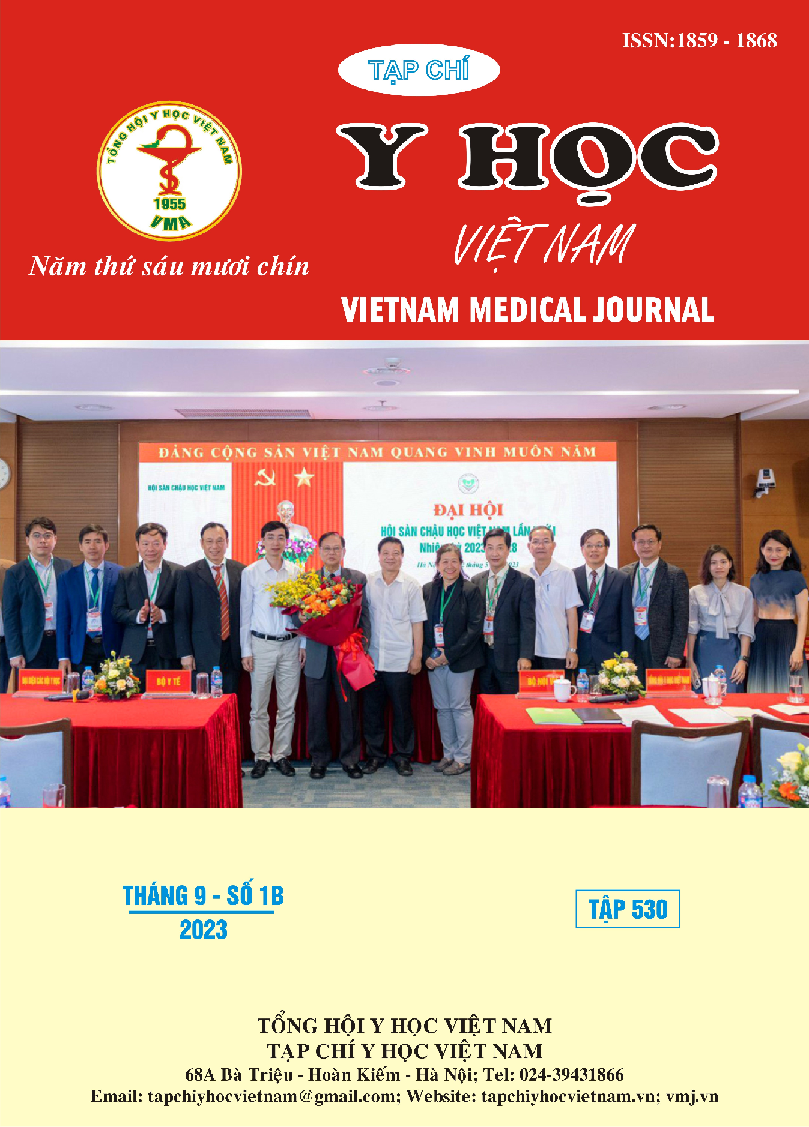RESEARCH ON THE CHARACTERISTICS OF NERVE FIBER LAYER AND MACULAR GANGLION CELLS IN CHILDREN AT HA DONG EYE HOSPITAL
Main Article Content
Abstract
DONG EYE HOSPITAL
Objective: To study the characteristics of nerve fiber layer and macular ganglion cells in children at Ha Dong Eye Hospital and related factors. Research method: Cross-sectional descriptive study at Ha Dong Eye Hospital on children aged 6-18 years, with refractive error of -3.00D to +3.00D and/or astigmatism < -2.00D. Exclusion criteria included strabismus, amblyopia, history of ocular diseases, family history of glaucoma, findings of corneal and macular abnormalities. Only reliable OCT Cirrus HD-OCT 5000 results (signal strength > 6/10) were selected for analysis. Results: The study group included 105 eyes of 55 children aged 6-18 years, with the following results: Mean age was 13.63 ± 2.87. The average thickness of the nerve fiber layer was 114.25 ± 21.90 µm, of which 89.5% had a thickness > 90 µm. The nerve fiber layer thickness decreased from superior (S): 136.90 ± 37.14 µm > inferior (I) 137.38 ± 37.19 µm > temporal (T) 95.52 ± 25 µm > nasal (N) 89.31 ± 27.61 µm. The average cup volume was 10.10 ± 0.75 mm3 with an average cup depth of 279.81 ± 22.47 µm. The overall average thickness of the ganglion cell-inner plexiform layer (GC-IPL) was 84.22 ± 15.71 µm. The highest thickness was in the superior temporal region and the lowest was in the inferior region. The thinnest part of ILM-PRE was in the central region, with the thinnest being in the outer ring region. The highest average thickness of ILM-PRE in the upper inner region and ILM-PRE in the lower inner region were 314.16 ± 20.79 µm and 308.22 ± 24.90 µm, respectively. The two regions with the lowest average thickness were ILM-PRE in the outer lower region with 271.31 ± 20.11 µm and ILM-PRE in the central region with 233.81 ± 30.40 µm. Conclusion: The study on 105 eyes has collected normal values for GC-IPL, RNFL, and cup volume in Vietnamese children. The results help identify changes in GC-IPL and RNFL thickness in children. The peripheral region area is related to RNFL thickness, while gender and refractive status are related to macular ganglion thickness. GC-IPL thickness is not affected by other factors and can be used for diagnosing and monitoring glaucoma pathology in children.
Article Details
Keywords
children, nerve fiber layer thickness, macular ganglion cells, optical coherence tomography (OCT)
References
2. Aref AA, Budenz DL. Spectral Domain Optical Coherence Tomography in the Diagnosis and Management of Glaucoma. Ophthalmic Surg Lasers Imaging. 2010; 41:S15-27.
3. Tariq YM, Li H, Burlutsky G. Retinal nerve fiber layer and optic disc measurements by spectral domain OCT: normative values and associations in young adults. Eye. 2012;26:1563-1570.
4. Goh JP, Koh V, Chan YH. Macular Ganglion Cell and Retinal Nerve Fiber Layer Thickness in Children with Refractive Errors-An Optical Coherence Tomography Study. J Glaucoma. 2017; 26:619-625.
5. Pham Thi Thuy Tien MD, Nguyen Quang Dai MD, Trang Thanh Nghiep MD. Macular ganglion cell and retinal nerve fiber layer thickness in normal Vietnamese children measured with optical cohenrence tomography. EyeSEA 2018;13(1):1-10.
6. Lee SY, Jeoung JW, Park KH. Macular ganglion cell imaging study: interocular symmetry of ganglion cell-inner plexiform layer thickness in normal healthy eyes. Am J Ophthalmol. 2015 ; 159:315-23.e2.
7. Masland RH. The neuronal organization of the retina. Neuron. 2012 Oct 18;76(2):266-80
8. Totan Y, Guragac FB, Guler E. Evaluation of the retinal ganglion cell layer thickness in healthy Turkish children. J Glaucoma. 2015;24:103-8.
9. Ooto S, Hangai M, Sakamoto A. Three-Dimensional Profile of Macular Retinal Thickness in Normal Japanese Eyes. IVOS Journal. 2010; 51:465-473.
10. Zhang Z, He X, Zhu J. Macular Measurements Using Optical Coherence Tomography in Healthy Chinese School Age Children. IVOS Journal. 2011;52:6377-83.


